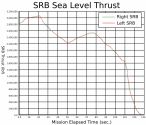Like I said HTPB, NEPE etc are binding processes. They're just different biding agents to the solid fuel mix which comes in powder form, and they only make up like 8-10% of the total with the majority being ammonium perchlorate. It's what gives the fuel mix the plasticity to turn into a useable solid fuel. These are essentially plastic explosives a la C-4 repurposed as propellants via controlled explosions.
There's not only one type of HTPB, itself a mixture that can be re-formulated into many varieties to suit the specific needs and parameters of a given fuel mix. The fact HTPB has been around for a long time is irrelevant as the polybutadiene base continues to be refined depending on use case.
PBAN is the same PB base re-tweaked for the SSSRB during the Space Shuttle era. NEPE is a different mixture entirely that primarily uses nitroglycerin as a base that supposedly squeezes more performance from the overall fuel mix as it doesn't require as much binding agent and plasticiser, so that a higher proportion is taken up by the primary oxidiser which is still ammonium perchlorate. The famous one being NEPE-75 inside the Trident II that has 75% solids, hence the name.
As I'm not a chemical engineer, please don't make me explain how these chemicals and mixtures differ in specific properties. All I know from my reading of the subject is that China has been using HTPB as the primarily solid fuel for missile boosters since the DF-21 days. Plenty of research has been done in China on NEPE, for sure. There're rumours DF-41 uses NEPE but these are still rumours.
As I said HTPB isn't one type of fuel as it continually gets refined and repurposed. Best example that's relevant to this topic is again the SRBs from the Ariane series, from the P241 EAP on Ariane 5 to the new P120 EAP on Ariane 6 where they all utilise AP/HTPB as fuel, and these SRBs are able to achieve higher specific impulses and fuel efficiencies over the SSSRB which uses a "newer" fuel that is PBAN-based.
As for N15, all I got from your quotes is that it having an "equivalent performance to NEPE" =/= it being NEPE.
Here's a research paper published by a team from several Chinese institutes, amongst them notably were the PLA Army Engineering University and the 713 Institute of CSIC i.e. China Shipbuilding Industry Corporation... interesting combo there to say the least, probably something to do with a certain "big wave" and a certain "easterly wind"
 Anyway, the paper talks about a new model for testing the elasticity of N15 under strain the Chinese team has developed, which is based on existing methodologies designed for HTPB-based solid propellants as their chemical compositions are the same/similar, and it references N15 as a HTPB propellant containing 70% solids in their tests.
Anyway, the paper talks about a new model for testing the elasticity of N15 under strain the Chinese team has developed, which is based on existing methodologies designed for HTPB-based solid propellants as their chemical compositions are the same/similar, and it references N15 as a HTPB propellant containing 70% solids in their tests.
Not a single mention of NEPE or other binders, nor would you expect them to as the chemical makeup would be different. This is as best of an English source with any authority that I could find.








